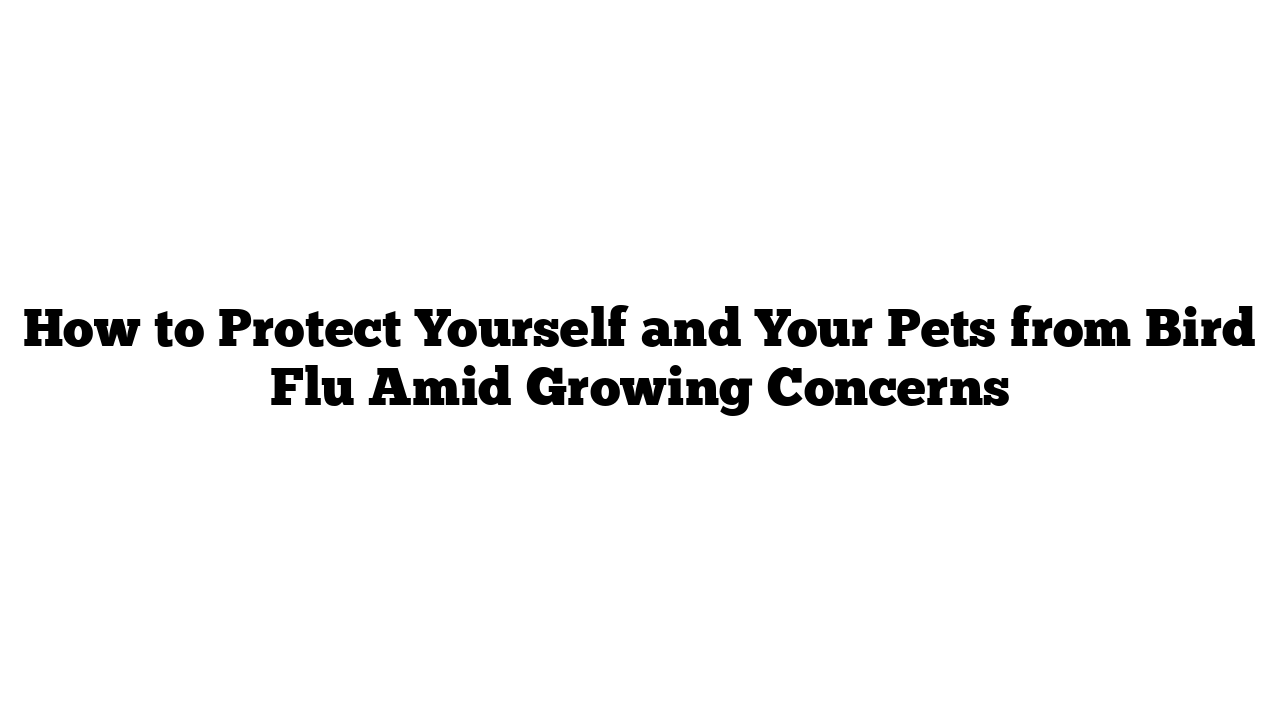Bird flu, or avian influenza, has made headlines recently, sparking concerns about its impact on humans and animals. With reports of a presumed positive case in a California child and ongoing fears about a potential pandemic, it’s essential to understand the risks and how to protect yourself. This article explores what bird flu is, how it spreads, and practical tips to safeguard yourself and your pets.
What is Bird Flu?
Bird flu refers to a group of influenza viruses that primarily affect birds. However, certain strains, like H5N1 and H7N9, can infect humans, leading to severe illness.
How Bird Flu Spreads
- Direct Contact with Birds
The virus spreads through contact with infected birds, including their feathers, droppings, or secretions. - Contaminated Surfaces
Touching surfaces contaminated with bird droppings or saliva can transmit the virus. - Human-to-Human Transmission
Although rare, human-to-human transmission can occur in close-contact settings.
Recent Concerns: A Closer Look
1. California Child Presumed Positive for Bird Flu
A recent case in California involving a child suspected of having bird flu highlights the virus’s potential to affect humans. Health officials are monitoring the situation closely to prevent further spread.
2. National Preparedness for a Pandemic
The United States is ramping up its preparedness for a potential bird flu pandemic. Efforts include monitoring poultry farms, developing vaccines, and stockpiling antiviral medications.
3. Protecting Pets from Bird Flu
Pets can also be at risk of bird flu, especially if they come into contact with infected birds. It’s crucial for pet owners to understand the precautions needed to keep their furry friends safe.
How to Protect Yourself and Your Pets
1. Avoid Contact with Wild Birds
Limit your exposure to wild birds and avoid areas where birds congregate, such as wetlands and bird markets.
2. Practice Good Hygiene
- Wash Your Hands: Use soap and water after handling birds or visiting areas with bird activity.
- Disinfect Surfaces: Clean surfaces that might be contaminated with bird droppings.
3. Keep Pets Safe
- Restrict Outdoor Access: Keep cats indoors and dogs on a leash when in areas with wild birds.
- Avoid Raw Bird Products: Do not feed pets raw poultry or eggs, as they may contain the virus.
4. Cook Poultry Thoroughly
Properly cooking poultry and eggs to an internal temperature of 165°F (74°C) kills the bird flu virus.
5. Stay Informed About Vaccinations
While a universal bird flu vaccine for humans isn’t yet available, researchers are making strides in vaccine development. Check with local health departments for updates.
Why Bird Flu is a National Concern
1. Economic Impact
Bird flu outbreaks can devastate the poultry industry, leading to increased food prices and economic losses.
2. Global Health Threat
Bird flu has pandemic potential. The H5N1 strain, for instance, has a high mortality rate among humans.
Quote: “Bird flu remains a significant global health challenge. Vigilance and preparedness are key to preventing its spread,” says a health expert from the CDC.
Signs and Symptoms of Bird Flu in Humans
If you’ve been exposed to birds or areas with bird flu outbreaks, watch for the following symptoms:
- Fever
- Cough
- Sore throat
- Muscle aches
- Severe cases may involve difficulty breathing or pneumonia.
Seek medical attention immediately if you experience these symptoms after exposure.
What is the U.S. Doing to Prepare?
The U.S. government is taking proactive steps to prevent and control bird flu outbreaks:
- Monitoring Poultry Farms: Regular inspections to detect and contain infections.
- Stockpiling Antivirals: Medications like oseltamivir (Tamiflu) are being stockpiled for emergency use.
- Public Awareness Campaigns: Educating the public about prevention and symptoms.
What Can You Do to Help?
1. Report Sick Birds
If you notice sick or dead birds in your area, report them to local wildlife authorities.
2. Support Vaccination Efforts
Encourage vaccination of poultry and advocate for increased research funding for human vaccines.
3. Educate Your Community
Share reliable information about bird flu prevention with friends and family.
For more details on protecting yourself and your pets, visit medicaltimes.io.
FAQs About Bird Flu
- What is bird flu?
Bird flu is an infectious disease caused by influenza viruses that primarily affect birds but can infect humans and animals. - Can pets catch bird flu?
Yes, pets can contract bird flu if they come into contact with infected birds or surfaces. - Is bird flu contagious among humans?
Human-to-human transmission is rare but possible in close-contact settings. - What are the symptoms of bird flu in humans?
Symptoms include fever, cough, sore throat, and in severe cases, pneumonia. - How can I protect myself from bird flu?
Avoid contact with wild birds, practice good hygiene, and cook poultry thoroughly. - Is there a vaccine for bird flu?
While there isn’t a universal vaccine, research is ongoing, and some vaccines exist for specific strains. - What should I do if I find a sick bird?
Report it to local wildlife or health authorities immediately. - Can bird flu outbreaks affect food supply?
Yes, outbreaks can impact poultry production, leading to higher food prices. - How is the U.S. preparing for a bird flu pandemic?
Efforts include monitoring, stockpiling antivirals, and raising public awareness. - Why is bird flu a global concern?
Bird flu has pandemic potential due to its high mortality rate in humans and global spread.
